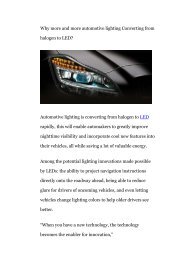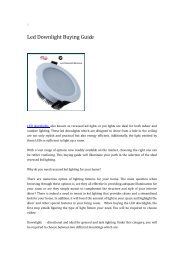A Better Lamp for Better Light
A few things to keep in mind while you’re shopping for LED light lamps:
A few things to keep in mind while you’re shopping for LED light lamps:
- TAGS
- led-bulb
Create successful ePaper yourself
Turn your PDF publications into a flip-book with our unique Google optimized e-Paper software.
A <strong>Better</strong> <strong>Lamp</strong> <strong>for</strong> <strong>Better</strong> <strong>Light</strong><br />
LED light lamps provide an enhanced lighting experience, generating true-to-nature<br />
tones and warm light that brings out the best in your home. Whether you need clear,<br />
radiant light in the kitchen, soft illumination in the bedroom, or cozy, inviting light in<br />
the family room, providing just the light you need. Unlike compact fluorescent bulbs<br />
(CFLs) LED lamps reach full brightness instantly, and are dimmable to the softest levels<br />
with absolutely no flickering or annoying buzz. Plus, they fit all of the lamps and<br />
fixtures you already have in your home, so you can switch over to LED lamps right away.<br />
Here are a few things to keep in mind while you’re shopping <strong>for</strong> LED light lamps:<br />
Lumens: You're probably used to choosing light bulbs based on watts, but lumens<br />
measure the amount of light emitted from the light bulb. A traditional 60-watt<br />
incandescent produces about 700 lumens, while a 100-watt generates approximately<br />
1,500 lumens of brightness, so those are the numbers you'll want to look <strong>for</strong>. With the<br />
highest lumen output of any LED bulb. Color is another important factor in choosing<br />
the right light. A light bulb's CRI (Color Rendering Index) gives you an idea of how<br />
accurate a light source renders color. Natural sun light has a CRI of 100, while a CRI<br />
around 80 is best <strong>for</strong> indoor lighting in a wide variety of applications. Another<br />
measurement of color is correlated color temperature (CCT) and is measure in degrees<br />
Kelvin (K). 2700K is a warm color temperature and matches what you are used to with<br />
an incandescent bulb. Look <strong>for</strong> color temperatures in the 4000K– 5000K range in<br />
rooms where you want the clearest, whitest light; while a CCT of 2700K will produce a<br />
softer, more yellow glow.






